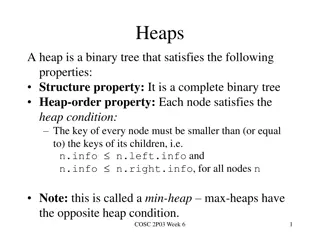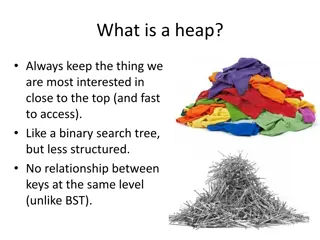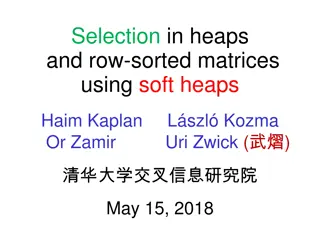Understanding Priority Queues and Heaps in Java Collections
Explore the concepts of priority queues, heaps, and related data structures in Java Collections Framework. Learn about the Priority Queue class, Entry ADT, Comparator ADT, and Total Order Relations, along with their practical applications in process scheduling and more.
Uploaded on Sep 10, 2024 | 0 Views
Download Presentation

Please find below an Image/Link to download the presentation.
The content on the website is provided AS IS for your information and personal use only. It may not be sold, licensed, or shared on other websites without obtaining consent from the author. Download presentation by click this link. If you encounter any issues during the download, it is possible that the publisher has removed the file from their server.
E N D
Presentation Transcript
Priority Queues & Heaps Chapter 9
The Java Collections Framework (Ordered Data Types) Iterable Interface Abstract Class Collection Class List Abstract Collection Queue Abstract List Abstract Queue Priority Queue Abstract Sequential List Vector Array List Stack Linked List
The Priority Queue Class Based on priority heap Elements are prioritized based either on natural order a comparator, passed to the constructor. Provides an iterator
Priority Queue ADT A priority queue stores a collection of entries Each entry is a pair (key, value) Main methods of the Priority Queue ADT insert(k, x) inserts an entry with key k and value x removeMin() removes and returns the entry with smallest key Additional methods min() returns, but does not remove, an entry with smallest key size(), isEmpty() Applications: Process scheduling Standby flyers
Total Order Relations Keys in a priority queue can be arbitrary objects on which an order is defined Mathematical concept of total order relation Reflexive property: x x Antisymmetric property: x y y x x = y Two distinct entries in a priority queue can have the same key Transitive property: x y y z x z
Entry ADT An entry in a priority queue is simply a key- value pair As a Java interface: /** * Interface for a key-value Methods: * pair entry getKey(): returns the key for this entry **/ public interface Entry { public Object getKey(); public Object getValue(); } getValue(): returns the value for this entry
Comparator ADT A comparator encapsulates the action of comparing two objects according to a given total order relation A generic priority queue uses an auxiliary comparator The comparator is external to the keys being compared When the priority queue needs to compare two keys, it uses its comparator The primary method of the Comparator ADT: compare(a, b): Returns an integer i such that i < 0 if a < b i = 0 if a = b i > 0 if a > b an error occurs if a and b cannot be compared.
Example Comparator /** Comparator for 2D points under the standard lexicographic order. */ public class Lexicographic implements Comparator { int xa, ya, xb, yb; public int compare(Object a, Object b) throws ClassCastException { xa = ((Point2D) a).getX(); ya = ((Point2D) a).getY(); xb = ((Point2D) b).getX(); yb = ((Point2D) b).getY(); if (xa != xb) return (xa - xb); else return (ya - yb); } } /** Class representing a point in the plane with integer coordinates */ public class Point2D protected int xc, yc; // coordinates public Point2D(int x, int y) { xc = x; yc = y; } public int getX() { return xc; } public int getY() { return yc; } } {
Sequence-based Priority Queue Implementation with an unsorted list Implementation with a sorted list 4 5 2 3 1 1 2 3 4 5 Performance: Performance: insert takes O(1) time since we can insert the item at the beginning or end of the sequence insert takes O(n) time since we have to find the right place to insert the item removeMin and min take O(1) time, since the smallest key is at the beginning removeMin and min take O(n) time since we have to traverse the entire sequence to find the smallest key Is this tradeoff inevitable?
Heaps Goal: O(log n) insertion O(log n) removal Remember that O(log n) is almost as good as O(1)! e.g., n = 1,000,000,000 log n 30 There are min heaps and max heaps. We will assume min heaps.
Min Heaps A min heap is a binary tree storing keys at its nodes and satisfying the following properties: Heap-order: for every internal node v other than the root key(v) key(parent(v)) (Almost) complete binary tree: let h be the height of the heap for i = 0, , h 1, there are 2i nodes of depth i at depth h 1 the internal nodes are to the left of the external nodes 2 Only the rightmost internal node may have a single child 5 6 9 7 The last node of a heap is the rightmost node of depth h
Height of a Heap Theorem: A heap storing nkeys has height O(log n) Proof: (we apply the complete binary tree property) Let h be the height of a heap storing n keys Since there are 2i keys at depth i=0, , h 1 and at least one key at depth h, we have n 1 + 2 + 4 + + 2h 1 + 1 Thus, n 2h, i.e., h log n depth keys 0 1 1 2 h 1 2h 1 h 1
Heaps and Priority Queues We can use a heap to implement a priority queue We store a (key, element) item at each internal node We keep track of the position of the last node For simplicity, we will typically show only the keys in the pictures (2, Sue) (5, Pat) (6, Mark) (9, Jeff) (7, Anna)
Insertion into a Heap Method insert of the priority queue ADT involves inserting a new entry with key k into the heap 2 5 6 z 9 7 The insertion algorithm consists of two steps new node Store the new entry at the next available location 2 5 6 Restore the heap-order property z 9 7 1
Upheap After the insertion of a new key k, the heap-order property may be violated Algorithm upheap restores the heap-order property by swapping k along an upward path from the insertion node Upheap terminates when the key k reaches the root or a node whose parent has a key smaller than or equal to k Since a heap has height O(log n), upheap runs in O(log n) time 2 1 5 1 5 2 9 7 6 9 7 6
Removal from a Heap Method removeMin of the priority queue ADT corresponds to the removal of the root key from the heap 2 5 6 w The removal algorithm consists of three steps 9 7 last node Replace the root key with the key of the last node w 7 Remove w 5 6 w Restore the heap-order property 9 new last node
Downheap After replacing the root key with the key k of the last node, the heap-order property may be violated Algorithm downheap restores the heap-order property by swapping key k along a downward path from the root Note that there are, in general, many possible downward paths which one do we choose? ? ? 7 5 6 w 9
Downheap We select the downward path through the minimum-key nodes. Downheap terminates when key k reaches a leaf or a node whose children have keys greater than or equal to k Since a heap has height O(log n), downheap runs in O(log n) time 7 5 5 6 7 6 w w 9 9
Array-based Heap Implementation We can represent a heap with n keys by means of an array of length n + 1 Links between nodes are not explicitly stored The cell at rank 0 is not used 2 5 6 The root is stored at rank 1. For the node at rank i 9 7 the left child is at rank 2i the right child is at rank 2i + 1 the parent is at rank floor(i/2) if 2i + 1 > n, the node has no right child 2 5 6 9 7 0 1 2 3 4 5 if 2i > n, the node is a leaf
Constructing a Heap A heap can be constructed by iteratively inserting entries: example. What is the running time? n T(n) nlogn. logi i=1 Can we do better?
Bottom-up Heap Construction We can construct a heap storing n keys using a bottom-up construction with log n phases 2i 1 2i 1 In phase i, each pair of heaps with 2i 1 keys are merged with an additional node into a heap with 2i+1 1 keys 2i+1 1
Merging Two Heaps 3 2 We are given two heaps and a new key k 8 5 4 6 We create a new heap with the root node storing k and with the two heaps as subtrees 7 3 2 8 5 4 6 We perform downheap to restore the heap- order property 2 3 4 8 5 7 6
Example 16 15 4 12 6 7 23 20 25 5 11 27 16 15 4 12 6 7 23 20
Example (contd.) 25 5 11 27 16 15 4 12 6 9 23 20 15 4 6 20 16 25 5 12 11 9 23 27
Example (contd.) 7 8 15 4 6 20 16 25 5 12 11 9 23 27 4 6 15 5 8 20 16 25 7 12 11 9 23 27
Example (end) 10 4 6 15 5 8 20 16 25 7 12 11 9 23 27 4 5 6 15 7 8 20 16 25 10 12 11 9 23 27
Bottom-Up Heap Construction Analysis In the worst case, each added node gets downheaped to the bottom of the heap. We analyze the run time by considering the total length of these downward paths through the binary tree as it is constructed. For convenience, we can assume that each path first goes right and then repeatedly goes left until the bottom of the heap (this path may differ from the actual downheap path, but this will not change the run time)
Analysis By assumption, each downheap path has the form RLL L. Each internal node thus originates a single right-going path. In addition, note that there is a unique path (sequence of R,L moves) from the root to each node in the tree. Thus each node can be traversed by at most one left-going path. Since each node is traversed by at most two paths, the total length of the paths is O(n) Thus, bottom-up heap construction runs in O(n) time Bottom-up heap construction is faster than n successive insertions (O(nlogn)).
Bottom-Up Heap Construction Uses downHeap to reorganize the tree from bottom to top to make it a heap. Can be written concisely in either recursive or iterative form.
Iterative MakeHeap MakeHeap(A,n) <pre-cond>:A[1 n] is a balanced binary tree <post-cond>:A[1 n] is a heap for i n /2 < LI >:All subtrees rooted at i +1 n are heaps DownHeap(A,i,n) downto 1
Recursive MakeHeap Get help from friends
Recursive MakeHeap Invoke as MakeHeap (A, 1, n) MakeHeap(A,i,n) <pre-cond>:A[i n] is a balanced binary tree <post-cond>:The subtree rooted at i is a heap if i n / 4 then MakeHeap(A,LEFT (i),n) MakeHeap(A,RIGHT (i),n) Downheap(A,i,n) i n /4 is grandp aren t f o n n /2 is p arent of n n Iterative and recursive methods perform exactly the same downheaps but in a different order. Thus both constructions methods are O(n).
Iterative vs Recursive MakeHeap Recursive and Iterative MakeHeap do essentially the same thing: Heapify from bottom to top. Difference: Recursive is depth-first Iterative is breadth-first
3 a Adaptable Priority Queues 5 g 4 e
Recall the Entry and Priority Queue ADTs An entry stores a (key, value) pair within a data structure Priority Queue ADT: insert(k, x) inserts an entry with key k and value x Methods of the entry ADT: removeMin() removes and returns the entry with smallest key getKey(): returns the key associated with this entry min() returns, but does not remove, an entry with smallest key getValue(): returns the value paired with the key associated with this entry size(), isEmpty()
Finding an entry in a heap by key Note that we have not specified any methods for removing or updating an entry with a specified key. These operations require that we first find the entry. In general, this is an O(n) operation: in the worst case, the whole tree must be explored.
Motivating Example Suppose we have an online trading system where orders to purchase and sell a given stock are stored in two priority queues (one for sell orders and one for buy orders) as (p,s) entries: The key, p, of an order is the price The value, s, for an entry is the number of shares A buy order (p,s) is executed when a sell order (p ,s ) with price p <p is added (the execution is complete if s >s) A sell order (p,s) is executed when a buy order (p ,s ) with price p >p is added (the execution is complete if s >s) What if someone wishes to cancel their order before it executes? What if someone wishes to update the price or number of shares for their order?
Additional Methods of the Adaptable Priority Queue ADT remove(e): Remove from P and return entry e. replaceKey(e,k): Replace with k and return the old key; an error condition occurs if k is invalid (that is, k cannot be compared with other keys). replaceValue(e,x): Replace with x and return the old value.
Example Operation insert(5,A) insert(3,B) insert(7,C) Output e1 e2 e3 e2 3 e1 3 C e2 P (5,A) (3,B),(5,A) (3,B),(5,A),(7,C) (3,B),(5,A),(7,C) (3,B),(5,A),(7,C) (3,B),(7,C) (7,C),(9,B) (7,D),(9,B) (7,D) min() key(e2) remove(e1) replaceKey(e2,9) replaceValue(e3,D) remove(e2)
Locating Entries In order to implement the operations remove(e), replaceKey(e,k), and replaceValue(e,x), we need a fast way of locating an entry e in a priority queue. We can always just search the entire data structure to find an entry e, but this takes O(n) time. Using location-aware entries, this can be reduced to O(1) time.
Location-Aware Entries A location-aware entry identifies and tracks the location of its (key, value) object within a data structure
List Implementation A location-aware list entry is an object storing key value position (or rank) of the item in the list In turn, the position (or array cell) stores the entry Back pointers (or ranks) are updated during swaps trailer nodes/positions header 5 d 8 b 2 c 4 a entries
Heap Implementation A location-aware heap entry is an object storing 2 d key value 4 a 6 b position of the entry in the underlying heap In turn, each heap position stores an entry Back pointers are updated during entry swaps 8 g 5 e 9 c
Performance Times better than those achievable without location-aware entries are highlighted in red: Method Unsorted List Sorted List Heap size, isEmpty O(1) O(1) O(1) insert O(1) O(n) O(log n) min O(n) O(1) O(1) removeMin O(n) O(1) O(log n) remove O(1) O(1) O(log n) replaceKey O(1) O(log n) O(n) replaceValue O(1) O(1) O(1)























